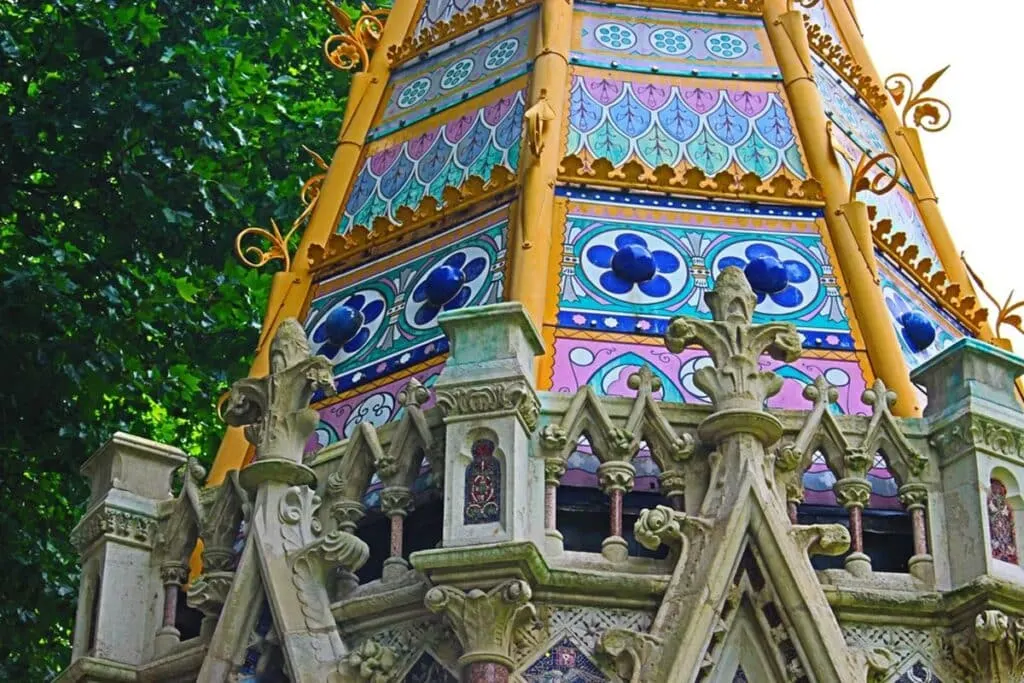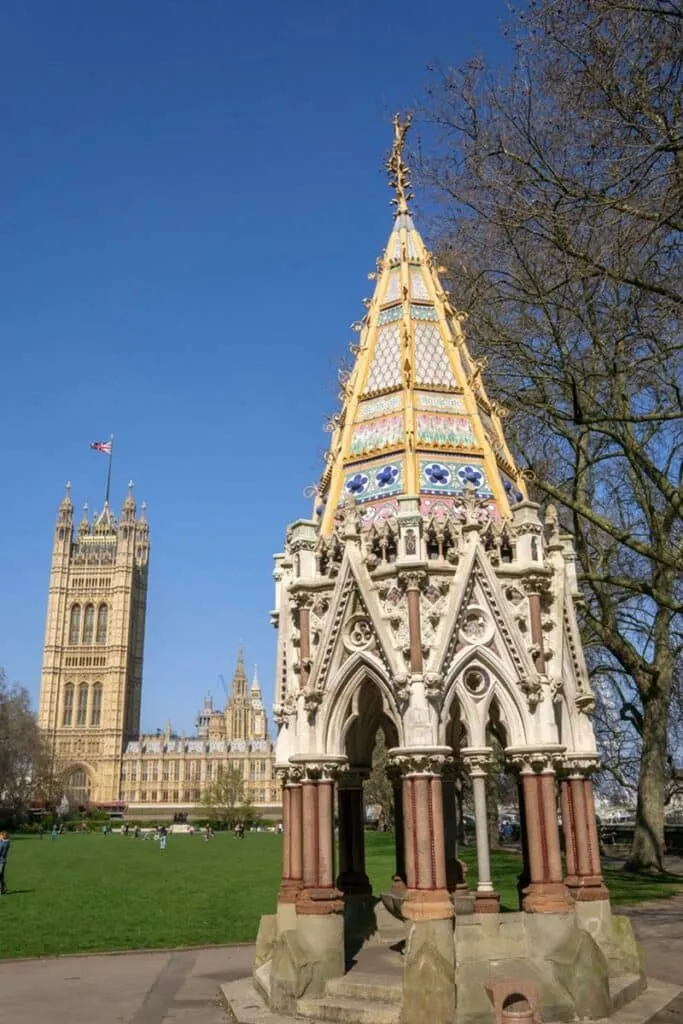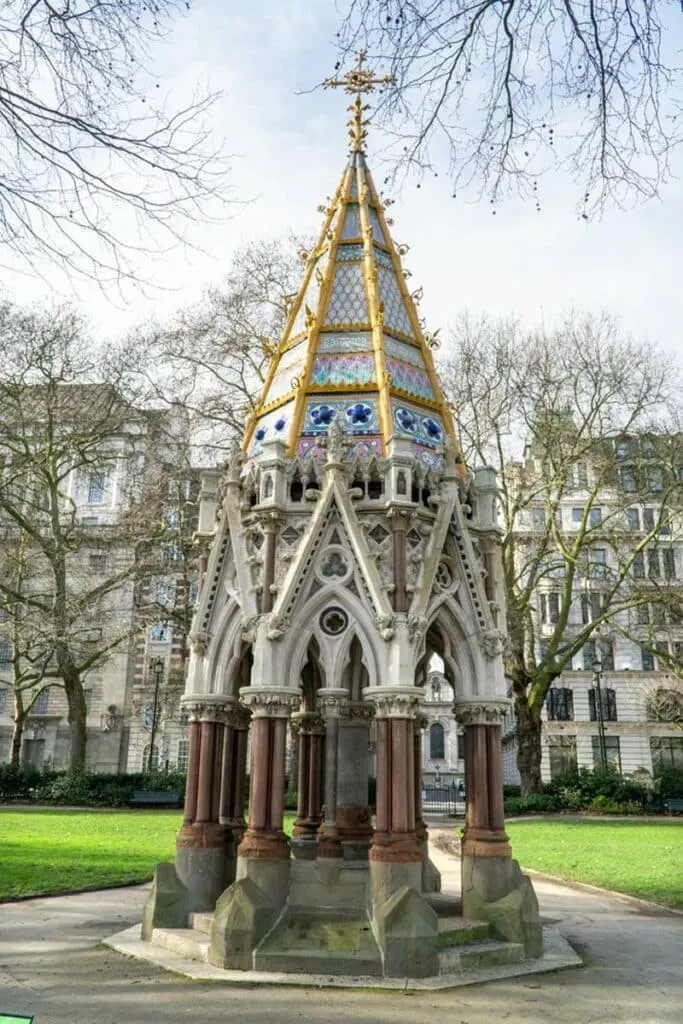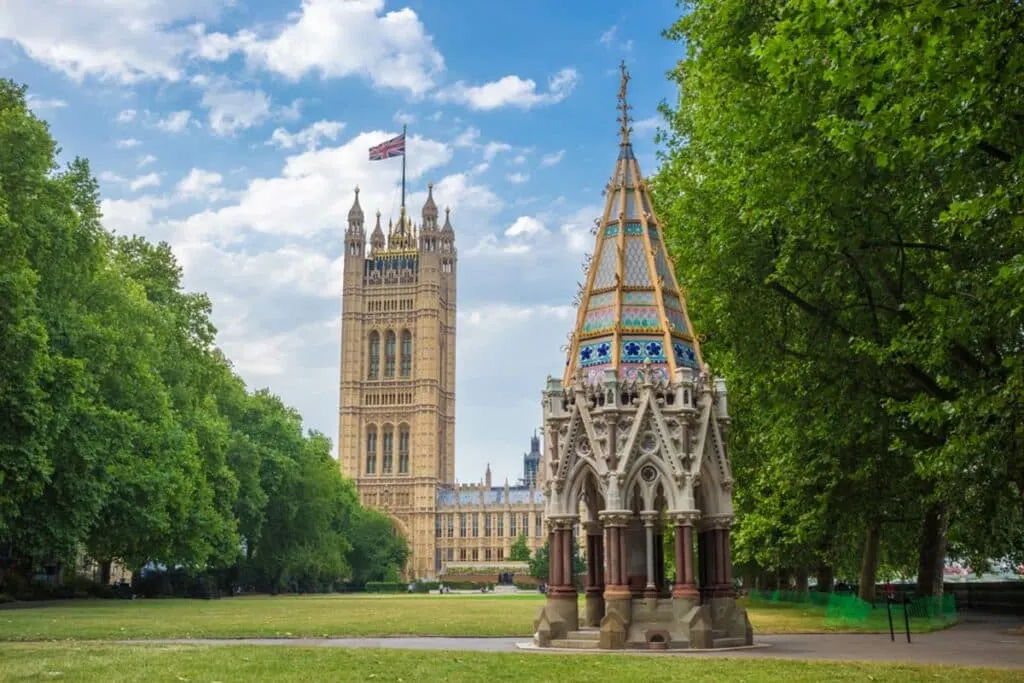Let’s explore Buxton Memorial Fountain. It’s time to discover the history of this Westminster memorial fountain and the very important story it tells.
If you’ve walked through Victoria Gardens before you may have noticed a few things. Primarily the side view of The Houses of Parliament – one not often photographed – and The Burghers of Calais sculpture by Auguste Rodin.
Down at the other end of the gardens though, is a structure with a very important history. The Buxton Memorial Fountain commemorates the emancipation of slaves in the British Empire, and the work of members of parliament to help bring about this momentous change in British law.
It’s part site of remembrance, part water fountain, and pretty stunning to look at.
Why Visit The Buxton Memorial Fountain?

There are several reasons to pop down to the Buxton Memorial Fountain. The most obvious is to just have a good look at this extravagant memorial. Another might be to have a drink…
The Buxton Memorial Fountain is exactly that, a drinking fountain. And before you ask, no it doesn’t have anything to do with Buxton water, the name is just a coincidence. It actually relates to Fowell Buxton, MP and abolitionist and that’s the biggest reason to come pay this memorial a visit.
It commemorates a piece of British history: the abolition of slavery. That also happens to be where the history of the Buxton Memorial Fountain begins.
The History of The Buxton Memorial Fountain
The Rule

It’s the 1830s. Britain is at the height of its power, in command of an empire that wraps itself around the whole world, from the treaty ports of southern China to dusty Australian prison towns and of course, the slave colonies of the Caribbean.
It’s not, we now understand, a pretty thing. We’d do well however to remember that was not how many people around the world viewed the British Empire at the time.
For most people living in the 1800s, imperialism was a fact of life. The imperialists would have seen it as their god-granted right to exploit the world for its resources, be it tea, spices or even slaves. The uglier side of this caste of imperialists even thought of the actions of the Empire as good, and noble.
As with all history, the story is never clear-cut. We need to disentangle ourselves from that very human trap of seeing the past through the lens of the present. The ugly truth is that for most of human history, the logic of conquer and exploit has been the rule that people everywhere have lived, and violently died by.
The Exception

There is little excuse for anything the British did in the Empire. One thing we can be a little more pleased with though, is the exception to the rule: Abolition.
By 1807 slavery had already been outlawed in the British Empire, but the law was struggling to enforce the rules on private companies thousands of miles away from London. It had taken William Wilberforce nearly 30 years to persuade Parliament to abolish slavery. It would take his followers another 30 years to enforce.
Among the people that joined Wilberforce’s cause was a man named Thomas Fowell Buxton. Along with Thomas Clarkson, Thomas Babington Macaulay, Henry Brougham and Stephen Lushington, they staked their careers to ensure that The Empire would be rid of slavery.
Their success in the rather undramatic fashion of parliamentary politics went against most of the institutions that were getting enormously rich from the slave trade. And they would go on to inspire a global movement for the abolition of slavery.
Make no mistake about it. These guys, against monumental odds, and a trend of history that’s entrenched in humanity’s darkest instincts, changed the world for good.
The Memorial

Only right they should be remembered then. Which is why you’re here in the first place: to get the low-down on the Buxton Memorial Fountain. It was raised by Charles Buxton, son of Thomas Fowell Buxton in honour of the work his father, Wilberforce and the other Abolitionists did for the cause.
Buxton was a bit of an amateur architect (apparently that was something you could be in the 1800s) and designed the memorial himself. It was done with the help of architect Samuel Teulon, whose neo-Gothic hand is visible in the style of the memorial.
As you’ll see, when you’re standing in front of the memorial, it’s octagonal and each face has an arch. Each of these arches houses an image of a British ruler, the most important in history.
The Briton King Caractacus is up there, as is Roman Constantine and Danish Canute. The Saxon king is Alfred and the Norman, William the Conqueror. The most recent of the eight is Queen Victoria, the monarch at the time of the memorial’s construction.
The drinking fountain bears an inscription in memory of the abolitionists, honouring the people who proved the exception to the rule and ended slavery.
The Buxton Memorial Fountain: Practical Information
Address: Victoria Gardens, 1 Millbank, London SW1P 3JU
Opening Times: Gardens open every day, 7am – 10pm
Tickets: You don’t need a ticket. Entering the gardens is free

